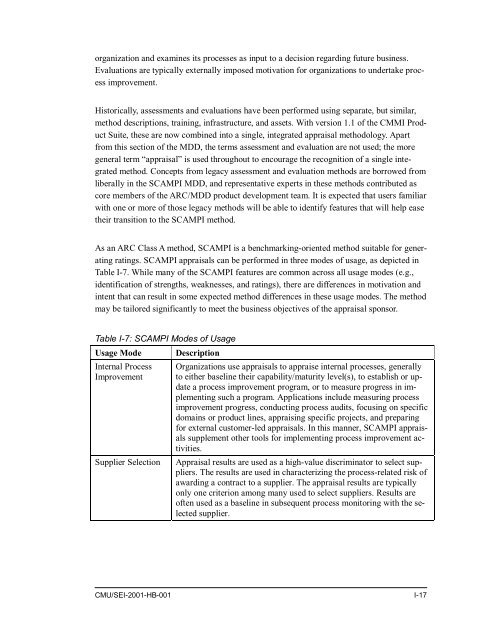Standard CMMI Appraisal Method for Process Improvement (SCAMPI)
Standard CMMI Appraisal Method for Process Improvement (SCAMPI)
Standard CMMI Appraisal Method for Process Improvement (SCAMPI)
You also want an ePaper? Increase the reach of your titles
YUMPU automatically turns print PDFs into web optimized ePapers that Google loves.
organization and examines its processes as input to a decision regarding future business.<br />
Evaluations are typically externally imposed motivation <strong>for</strong> organizations to undertake process<br />
improvement.<br />
Historically, assessments and evaluations have been per<strong>for</strong>med using separate, but similar,<br />
method descriptions, training, infrastructure, and assets. With version 1.1 of the <strong>CMMI</strong> Product<br />
Suite, these are now combined into a single, integrated appraisal methodology. Apart<br />
from this section of the MDD, the terms assessment and evaluation are not used; the more<br />
general term “appraisal” is used throughout to encourage the recognition of a single integrated<br />
method. Concepts from legacy assessment and evaluation methods are borrowed from<br />
liberally in the <strong>SCAMPI</strong> MDD, and representative experts in these methods contributed as<br />
core members of the ARC/MDD product development team. It is expected that users familiar<br />
with one or more of those legacy methods will be able to identify features that will help ease<br />
their transition to the <strong>SCAMPI</strong> method.<br />
As an ARC Class A method, <strong>SCAMPI</strong> is a benchmarking-oriented method suitable <strong>for</strong> generating<br />
ratings. <strong>SCAMPI</strong> appraisals can be per<strong>for</strong>med in three modes of usage, as depicted in<br />
Table I-7. While many of the <strong>SCAMPI</strong> features are common across all usage modes (e.g.,<br />
identification of strengths, weaknesses, and ratings), there are differences in motivation and<br />
intent that can result in some expected method differences in these usage modes. The method<br />
may be tailored significantly to meet the business objectives of the appraisal sponsor.<br />
Table I-7: <strong>SCAMPI</strong> Modes of Usage<br />
Usage Mode Description<br />
Internal <strong>Process</strong><br />
<strong>Improvement</strong><br />
Supplier Selection<br />
Organizations use appraisals to appraise internal processes, generally<br />
to either baseline their capability/maturity level(s), to establish or update<br />
a process improvement program, or to measure progress in implementing<br />
such a program. Applications include measuring process<br />
improvement progress, conducting process audits, focusing on specific<br />
domains or product lines, appraising specific projects, and preparing<br />
<strong>for</strong> external customer-led appraisals. In this manner, <strong>SCAMPI</strong> appraisals<br />
supplement other tools <strong>for</strong> implementing process improvement activities.<br />
<strong>Appraisal</strong> results are used as a high-value discriminator to select suppliers.<br />
The results are used in characterizing the process-related risk of<br />
awarding a contract to a supplier. The appraisal results are typically<br />
only one criterion among many used to select suppliers. Results are<br />
often used as a baseline in subsequent process monitoring with the selected<br />
supplier.<br />
CMU/SEI-2001-HB-001 I-17
















